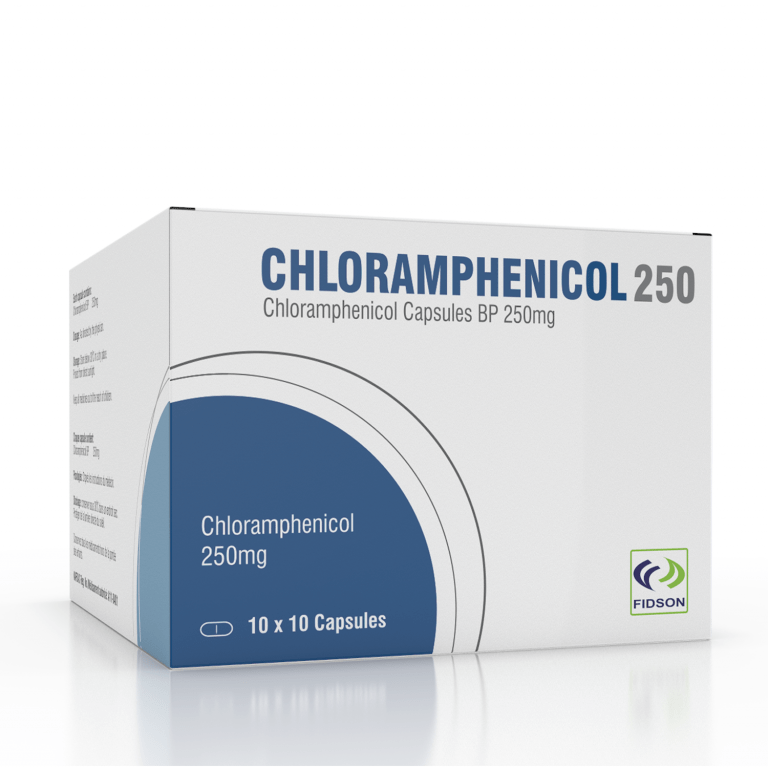PATIENT INFORMATION LEAFLET: INFORMATION FOR THE USER
CHLORAMPHENICOL CAPSULES (PDF DOWNLOAD)
Chloramphenicol BP 250mg
Pharmacodynamic Properties
Chloramphenicol is a broad-spectrum antibiotic acting by interfering with bacterial protein synthesis.
The most important action on the body tissue is the one of bone marrow depression. There is significant plasma protein binding and the drug is largely inactivated in the liver.
Pharmacokinetic Properties
Chloramphenicol is readily and rapidly absorbed from the Gastrointestinal tract. Particle size may affect rate of absorption but will not affect total absorption. Significant serum levels are observable within 30 minutes after ingestion and half-life may be 2 – 5 hours.
Chloramphenicol is widely distributed in body tissues and fluids. It is found in cerebro-spinal fluid. It crosses the placental barrier and diffuses into breast milk. There is significant plasma protein binding (up to 60%).
Excretion is mainly in the urine.
Indication(s)
Chloramphenicol Capsule is used for typhoid fever, bacterial infections of the outer ear, Severe bacterial infection, cholera, eye infections, plague and other conditions particularly those caused by Haemophilus influenzae, where other antibiotics will not suffice.
Contra-indications
Known hypersensitivity or toxic reaction to chloramphenicol or to any of the excipients.
Chloramphenicol is contra-indicated in prophylaxis or treatment of minor infections; during active immunisation; and in porphyria patients.
Chloramphenicol is contra-indicated in patients taking drugs liable to depress bone marrow function.
Chloramphenicol must not be used in breast-feeding mothers and during pregnancy or labour, due to a risk of foetal/ infant damage (Gray Baby syndrome).
Warning and Precaution
Chloramphenicol should only be used if other treatments are ineffective and its use should always be carefully monitored.
Dose reduction and plasma level monitoring may be required in patients with hepatic or renal impairment in the elderly and in patients concurrently treated with interacting drugs.
Periodic blood testing should be conducted during prolonged or repeated treatment. Chloramphenicol should be discontinued if a significant detrimental effect is seen
Usage in Pregnancy/Lactation
The use of chloramphenicol is contra-indicated as the drug crosses the placenta and is excreted in breast milk.
Adverse-effects
Hypersensitivity reactions: Macular or vesicular skin rashes occur as a result of hypersensitization to chloramphenicol. Fever may appear simultaneously or be the sole manifestation. Angioedema is a rare complication. Herxheimer reactions have been observed. Erythema multiforme has been reported.
Hematological Toxicity: The most important adverse effect of chloramphenicol is on the bone-marrow.
Changes in peripheral blood include leukopenia, thrombocytopenia, and aplasia of the marrow with fatal pancytopenia. The incidence is not dose-related. The fatality rate is high when bone-marrow aplasia is complete, and there is a high incidence of acute leukemia in those who recover.
A second haematological effect of chloramphenicol is a predictable but reversible erythroid suppression of the bone marrow. The clinical picture is featured initially by reticulopenia, which occurs 5 to 7 days after the initiation of therapy, followed by a decrease in haemoglobin, an increase in plasma iron, cytoplasmic vacuolation of early erythroid forms and granulocyte precursors, and normoblastosis with a shift to early erythrocyte forms. Severe leukopenia and thrombocytopenia may also occur. The incidence and severity of this syndrome are dose-related. It occurs regularly when plasma concentrations are 25µg/mL or higher and is observed during the use of large doses of chloramphenicol, prolonged treatment, or both. Haemolytic anaemia has occurred in persons with a genetic deficiency of glucose-6-phosphate dehydrogenase activity.
Other Effects: Gastrointestinal symptoms including nausea, vomiting, unpleasant taste, diarrhoea and perineal irritation may follow oral administration of chloramphenicol. Disturbances of the oral and intestinal flora may cause stomatitis, glossitis, and rectal or vaginal irritation.
Prolonged oral administration of chloramphenicol may induce bleeding either, by bone-marrow depression or by reducing the intestinal flora with consequent inhibition of vitamin K synthesis and greatly increased prothrombin time.
Among the toxic effects produced by chloramphenicol are blurring of vision and digital paresthesias. Peripheral as well as optic neuritis has been reported in patients receiving chloramphenicol, usually over prolonged periods.
A toxic manifestation – “the grey syndrome”– has occurred in premature and other newborn infants receiving large doses of chloramphenicol. A similar syndrome has been reported in adults and children given high doses. Chloramphenicol should never be given for minor infections or for prophylaxis and repeated courses and prolonged treatment should be avoided.
Reduced doses should be given to patients with impaired liver function. Uraemic patients may be more susceptible to the depressant effect of chloramphenicol on bone-marrow but reducing the dose may result in inadequate plasma concentrations. Routine periodic blood examinations are advisable in all patients including infants; these examinations will not warn of aplastic anaemia.
Because of the risk of the “grey” syndrome, newborn infants should not be given chloramphenicol, unless it may be lifesaving and there is no alternative treatment. The use of chloramphenicol is best avoided during pregnancy; nursing infants should be observed with care since chloramphenicol given to the mother is excreted in the milk.
Possible drug interactions
Warfarin, Phenytoin, Sulphonylureas, Tolbutamide: Chloramphenicol prolongs the elimination, increasing the blood levels of drugs including Warfarin, Phenytoin, Sulphonylureas, Tolbutamide.
Anticonvulsants and Anticoagulants: Doses of anticonvulsants and anticoagulants may need to be adjusted if given concurrently.
Penicillins and Rifampicin
Complex effects (including reduced / increased plasma levels) requiring monitoring of chloramphenicol plasma levels have been reported with co-administration of penicillins and rifampicin.
Paracetamol: Concurrent administration of paracetamol should be avoided as this prolongs chloramphenicol half-life.
Calcineurin Inhibitors (CNIs) – Ciclosporin and Tacrolimus: Treatment with chloramphenicol possibly increases the plasma levels of the CNIs, Ciclosporin and Tacrolimus.
Barbiturates: The metabolism of chloramphenicol is accelerated by barbiturates, such as phenobarbitone, leading to reduced plasma concentrations. There is a possible decrease in the metabolism of Phenobarbitone with concomitant chloramphenicol administration.
Oestrogens: There is a small risk that chloramphenicol may reduce the contraceptive effect of oestrogens.
Hydroxocobalamin: Chloramphenicol reduces the response to hydroxocobalamin.
Drugs causing agranulocytosis: Chloramphenicol is contra-indicated in patients taking drugs liable to suppress bone marrow function. These include: Carbamazapine, Sulphonamides, Phenylbutazone, Penicillamine, Cytotoxic agents; Some antipsychotics, including clozapine and particularly depot antipsychotics, Procainamide, Nucleoside reverse transcriptase inhibitors, Propylthiouracil
Dosage and administration
Adults: 500 mg every 6 hours or 50 mg/kg body mass daily in divided doses every 6 hours.
The dose of chloramphenicol should be reduced in the presence of hepatic disease or in patients with renal insufficiency.
Children: 25 to 50 mg/kg body weight daily, given in divided doses at intervals of 6 hours.
Storage
Store below 30oC in a dry place. Keep all medicines out of reach of children
Presentation
10 x 10 Capsules in a sachet, placed in an outer carton with insert.






